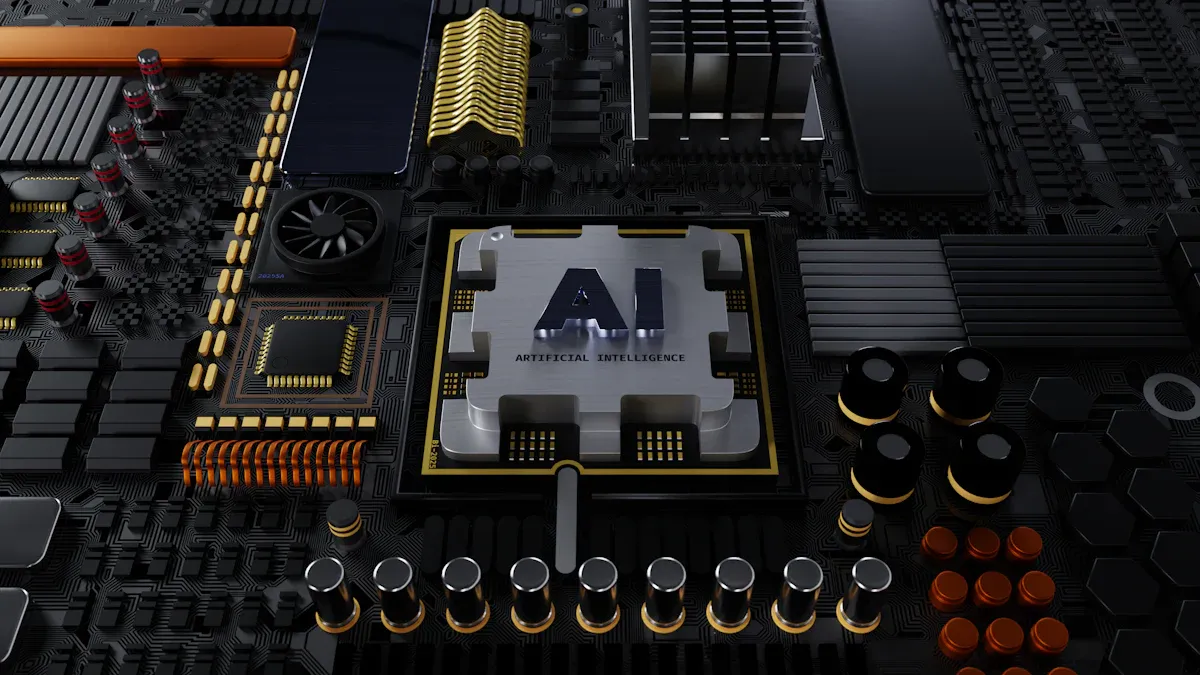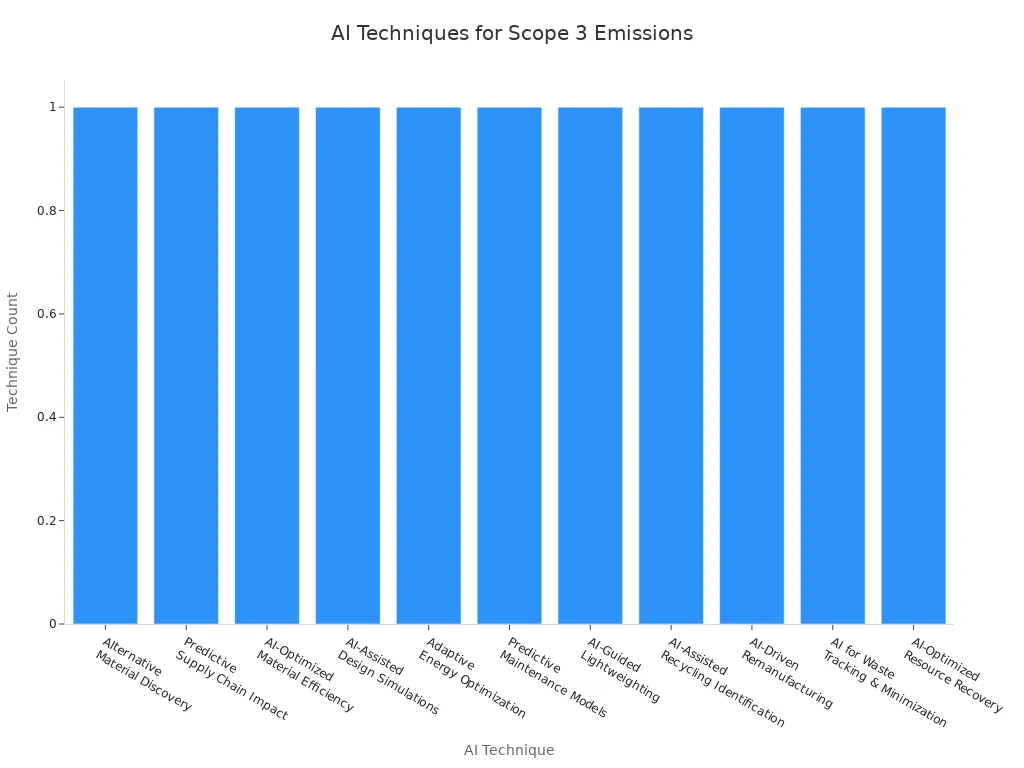Elevating Green Procurement in Electronics using AI-Driven Digital Platforms

AI-driven digital platforms now play a critical role in green procurement across the electronics sector. These systems analyze supplier data on cost, delivery, quality, and sustainability performance. Companies gain better transparency and traceability, ensuring ethical sourcing and strong environmental standards. Predictive analytics help firms anticipate disruptions and optimize logistics to reduce emissions. By supporting waste reduction and resource efficiency, AI makes green procurement more effective and supports a circular economy in electronics.
Key Takeaways
AI-driven platforms speed up supplier evaluation and help companies find sustainable suppliers quickly and reliably.
These platforms use data and AI tools to track carbon emissions, waste, and ethical practices, making green procurement more transparent and effective.
AI automates routine tasks and supports compliance with global sustainability regulations, reducing errors and saving time.
Companies face challenges like data quality and system integration but can overcome them with clean data, training, and phased implementation.
Adopting AI in procurement improves supply chain resilience, lowers environmental impact, and strengthens brand trust.
AI’s Role in Green Procurement

Supplier Evaluation
AI-driven platforms have transformed how companies evaluate suppliers in the electronics industry. These systems analyze vast amounts of data, including trade records, certifications, and compliance documents. AI can scan and filter suppliers based on their reliability, expertise, and sustainability commitments. Companies now discover and assess suppliers in minutes instead of weeks.
AI-powered supplier discovery reduces search time by over 90%.
Predictive analytics check on-time delivery rates and production capacity.
AI ranks suppliers by relevance, pricing, and environmental standards.
Detailed supplier profiles include ownership, customer feedback, and financial stability.
AI detects fraudulent suppliers and predicts price changes.
AI automates routine procurement tasks, such as sending requests for information and monitoring suppliers in real time. This automation supports green procurement by ensuring that only suppliers with strong sustainability practices enter the supply chain.
The most common sustainability metrics used by AI systems to evaluate electronics suppliers include:
Metric | What it Measures | Why it Matters |
|---|---|---|
Carbon emissions | Reduction of carbon footprint and transition to cleaner energy | Essential for addressing climate change and meeting regulatory requirements |
Water management | Responsible use, recycling, and protection of water resources | Critical for sectors like manufacturing that heavily rely on water, reducing environmental impact |
Circular economy | Waste minimization through recycling and reuse | Promotes sustainable production by supporting closed-loop systems |
Human rights & diversity | Ethical labor practices and inclusivity | Identifies and prevents forced labor and human trafficking in global supply chains |
Ethics and compliance | Adherence to regulations and maintaining transparency | Ensures legal compliance, builds trust, and reduces risks from unethical behavior |
Beyond these metrics, leading suppliers set measurable sustainability goals and innovate in green technology and worker well-being. Social impact ratings and lifecycle sustainability analysis help companies identify improvement opportunities, such as energy-efficient production and optimized transportation.
ESG Scoring
Environmental, Social, and Governance (ESG) scoring has become a key part of green procurement. AI systems use machine learning and natural language processing to review supplier sustainability questionnaires and score responses. Generative AI creates customized questionnaires and evaluates answers based on ESG criteria.
Machine learning algorithms optimize supplier selection and predict demand.
Natural language processing extracts key terms from contracts and flags risks.
Generative AI scores supplier responses and generates sustainability reports.
AI-driven ESG scoring helps companies compare suppliers fairly and transparently. These systems look at environmental impact, social responsibility, and ethical business practices. By automating ESG scoring, companies can focus on suppliers who align with their sustainability goals.
Tip: Automated ESG scoring reduces human bias and speeds up decision-making, making green procurement more reliable and efficient.
Carbon Management
Managing carbon emissions, especially Scope 3 emissions, is one of the biggest challenges in electronics procurement. AI-driven platforms automate the collection and analysis of carbon data by connecting with procurement systems, utility meters, logistics trackers, and IoT sensors. This integration gives companies real-time visibility into emissions across the supply chain.

The latest AI techniques for managing Scope 3 emissions include:
AI Technique | Description | Impact on Scope 3 Emissions |
|---|---|---|
Alternative Material Discovery | Finds sustainable, bio-based, or recycled materials | Reduces emissions by replacing carbon-intensive materials |
Predictive Supply Chain Impact | Forecasts emissions and optimizes sourcing decisions | Enables selection of low-emission suppliers |
AI-Optimized Material Efficiency | Optimizes raw material use, reducing waste | Lowers carbon footprint per product |
AI-Assisted Design Simulations | Tests product designs virtually for efficiency | Minimizes material use and lifetime CO2 emissions |
Adaptive Energy Optimization | Adjusts product energy use in real time | Reduces in-use energy consumption and extends product lifespan |
Predictive Maintenance Models | Predicts equipment wear to schedule maintenance | Extends product life and lowers emissions from manufacturing and transport |
AI-Guided Lightweighting | Finds material-efficient structures without compromising safety | Decreases product weight, reducing emissions from transportation and energy use |
AI-Assisted Recycling Identification | Automates waste sorting and improves recycling quality | Increases recycling rates and lowers emissions from raw material extraction |
AI-Driven Remanufacturing | Assesses used components for refurbishment potential | Reduces need for virgin materials and emissions from new part manufacturing |
AI for Waste Tracking & Minimization | Monitors waste generation and optimizes inventory and demand forecasting | Minimizes waste at source, improving resource utilization and cutting emissions |
AI-Optimized Resource Recovery | Identifies and extracts valuable materials from waste streams efficiently | Enhances material recovery rates and lowers emissions |
AI-driven platforms also support regulatory compliance by automating emissions tracking and reporting. These systems provide audit-ready carbon footprints and scenario modeling, helping companies meet global standards such as the EU’s CSRD and California’s SB 253. By enabling real-time tracking and proactive emissions reduction, AI ensures that green procurement strategies remain effective and compliant.
Overcoming Procurement Challenges
Data Quality
Electronics supply chains generate massive amounts of data from suppliers, logistics, and compliance documents. Procurement teams often struggle with incomplete or outdated information. AI-driven platforms address this by cleansing and enriching supplier data from multiple sources. These systems ensure data completeness and timeliness. They analyze sustainability metrics such as carbon emissions and waste management. Procurement teams use these insights to identify suppliers that meet specific sustainability criteria. AI also automates compliance monitoring, reducing the risk of non-compliance. Cognitive analytics provide prescriptive recommendations, such as suggesting alternative suppliers with lower environmental impact. This approach makes sustainability assessments more transparent and data-driven, improving decision-making.
Tip: Reliable data forms the foundation for effective sustainability strategies in electronics procurement.
Integration
Integrating AI platforms with existing procurement systems presents unique challenges. Companies must connect new solutions with ERP and procurement software to avoid data silos and maintain visibility. Data readiness is critical, requiring clean, structured, and centralized information. Deployment may need specialized hardware or cloud infrastructure. Multinational organizations face additional hurdles due to varying regulations across countries. Smaller companies often lack technical expertise, leading to reliance on third-party providers and raising concerns about data privacy and security. Change management and training remain essential for successful adoption.
Common integration issues include:
Need for seamless connection with ERP and procurement systems
Data readiness and centralization
Deployment complexity with hardware or cloud requirements
Regulatory differences across countries
Limited internal expertise in smaller organizations
Importance of change management and training
AI solutions like GEP SMART help by layering onto existing systems, offering scalability and security. Features such as predictive analytics, automated workflows, and intelligent search simplify procurement tasks. User-friendly interfaces and mobile access encourage adoption. Phased implementation and pilot projects minimize disruption and build momentum for broader AI use.
Regulatory Compliance
Electronics companies must navigate a complex web of global regulations. In the EU, rules focus on device longevity, recyclability, and energy efficiency. The US enforces recycling laws, hazardous waste management, and energy standards. Federal agencies must prioritize environmentally preferable and energy-efficient products. Certifications like ENERGY STAR, EPEAT, and Green Seal set benchmarks for sustainable electronics.
AI-driven platforms support compliance by:
Aggregating and analyzing ESG data from diverse sources
Detecting trends and anomalies for comprehensive evaluations
Benchmarking performance against industry standards
Forecasting ESG risks with predictive analytics
Automating materiality reports for regulations like CSRD
Facilitating scenario analysis and digital twin simulations
Tailoring ESG reports for different stakeholders
Monitoring regulatory changes and automating compliance checks
These capabilities help electronics companies meet evolving sustainability regulations efficiently and accurately.
Real-World Impact

Case Studies
Electronics companies have adopted AI-powered platforms to accelerate supplier discovery and improve sustainability outcomes. The following table highlights how leading organizations use these technologies:
Company | AI Platform Used | Use Case Description | Outcome / Benefits |
|---|---|---|---|
Siemens Energy | Scoutbee | Needed suppliers for photovoltaic systems due to new regulations; AI scanned global markets to find suppliers. | Identified 59 new suppliers in 12 countries within 4 weeks; accelerated sourcing and improved resilience. |
Siemens | AI system | Faced shortage of specialized resin Surlyn; AI analyzed import/shipping data to find distributors. | Generated list of 150 distributors quickly; enabled faster supply securing than traditional methods. |
Cisco | TealBook | Focused on supplier diversity; AI helped identify minority-owned, veteran-owned, and regionally diverse suppliers. | Reduced time and effort in finding diverse suppliers; improved alignment with diversity goals. |
Kärcher | Scoutbee | Needed suppliers for motors, injection-molded parts, chemicals; AI accelerated supplier scouting. | Completed supplier scouting in weeks; maintained supply during COVID-19; gained market share. |
PepsiCo | Veridion | Used AI to discover and manage suppliers globally; integrated AI data into procurement systems. | Access to 60+ data points per supplier; real-time alerts on risks; improved sourcing efficiency and risk mitigation. |
These examples show how AI-driven platforms help companies respond quickly to market changes, maintain supply chain resilience, and support green procurement goals.
Measurable Benefits
AI-driven digital platforms deliver measurable benefits for electronics procurement teams. Companies experience improved transparency and traceability, which supports ethical sourcing and sustainability reporting. AI enables real-time monitoring of carbon emissions and energy use, helping organizations meet reduction targets. Waste tracking and management become more efficient, leading to environmentally friendly procurement practices.
AI improves data traceability, making sustainability reporting easier and more accurate.
Energy efficiency solutions powered by AI reduce energy consumption and greenhouse gas emissions.
Carbon footprint calculation tools allow companies to monitor emissions across supply chains and take targeted action.
Enhanced transparency through blockchain and AI ensures ethical and sustainable sourcing.
Automation reduces manual tasks, enforces compliance, and minimizes waste.
Supplier collaboration increases through real-time communication and shared sustainability goals.
AI-powered risk profiles support responsible sourcing and decision making.
UPS and DHL use AI to optimize delivery routes and predict maintenance needs. These applications lower fuel use and emissions, improve supply chain transparency, and increase resilience. Companies using AI for emissions measurement are twice as likely to meet reduction goals. The combination of AI insights and human expertise drives continuous improvement in supplier sustainability practices.
AI-driven platforms help electronics companies achieve green procurement by making supply chains more transparent, resilient, and ethical.
Implementation Steps
Readiness
Electronics companies begin by mapping and auditing their current procurement processes. They identify repetitive tasks that AI can automate. Teams collect as much procurement data as possible, even if some data is not ready for immediate use. This approach helps AI systems learn and improve over time. Companies select analytics and AI solutions that match their automation and sustainability goals. They build workflows with approval points to keep human oversight in place. Measuring the success of automation and making improvements is an ongoing process.
Key Focus for Readiness Assessment | |
|---|---|
Strategy | Align AI strategy with leadership and sustainability goals. |
Infrastructure | Invest in secure, scalable systems for AI workloads. |
Data | Ensure data quality and break down silos. |
Governance | Update policies for ethical AI use and compliance. |
Culture | Support innovation and sustainability. |
Talent | Develop skills in AI and green procurement. |
Tip: Start with routine procurement challenges and encourage collaboration between people and AI.
Integration
Successful integration of AI-driven platforms requires careful planning. Companies assess the total cost of AI tools, including hardware, training, and maintenance. They involve teams from IT, procurement, and other departments early in the process. Clean, structured, and accessible data is essential for smooth integration. Companies often begin with high-volume, repetitive tasks like invoice matching to show quick results. They choose AI tools that fit business needs and work well with existing systems. Security and privacy remain top priorities, so companies use strong controls and regular audits.
Invest in flexible infrastructure, such as cloud solutions.
Use automated data pipelines for efficient data management.
Design modular AI systems for easy updates.
Monitor AI performance and optimize as needed.
Address data quality and integration challenges with strong governance.
Change Management
Change management plays a key role in adopting AI for green procurement. Clear communication helps teams understand the benefits and reduces fear of job loss. Training programs close skill gaps and build confidence in using new tools. Companies start with small pilot projects to test AI solutions and gather feedback. Cross-functional collaboration brings together procurement, IT, and finance teams. Continuous support and supervision help address barriers and keep adoption on track.
Note: Building trust through transparency and education encourages acceptance of AI-driven platforms.
Companies maintain ethical standards by ensuring fairness and data privacy. They monitor user feedback and performance metrics to improve systems over time. By following these steps, electronics companies can elevate green procurement and achieve better sustainability outcomes.
AI-driven platforms transform green procurement in electronics by enabling intelligent supplier rating, product traceability, and optimized logistics. Companies benefit from automated auditing, predictive waste reduction, and carbon-neutral requisition routing. These innovations help manufacturers reduce energy use, cut emissions, and comply with global sustainability standards.
Real-time risk monitoring and automated contract management improve efficiency.
Predictive analytics and impact measurement support strategic decision-making.
Circular supply chains and digital twins promote eco-friendly manufacturing.
Long-Term Benefit | Description |
|---|---|
Automation and optimized logistics lower operational expenses. | |
Regulatory Compliance | AI streamlines reporting and helps meet sustainability regulations. |
Brand Trust | Eco-friendly practices strengthen customer loyalty and market position. |
Operational Efficiency | 24/7 automation increases throughput and reduces errors. |
Electronics companies should define clear objectives, invest in training, and adopt scalable AI solutions. By acting now, organizations build resilient, future-ready supply chains and lead the way in sustainable procurement.
FAQ
What is green procurement in electronics?
Green procurement in electronics means choosing products and suppliers that follow environmental standards. Companies look for items that use less energy, create less waste, and support recycling. This process helps protect the planet and meets new regulations.
How does AI help companies find sustainable suppliers?
AI scans supplier data and ranks them by sustainability. The system checks certifications, reviews feedback, and tracks carbon emissions. Companies use these insights to select suppliers who meet their green goals.
Tip: AI can reduce supplier search time from weeks to minutes.
What challenges do companies face when using AI for green procurement?
Companies often struggle with data quality, system integration, and changing regulations. They need clean data and strong security. Training teams and updating processes help overcome these challenges.
Challenge | Solution |
|---|---|
Data quality | Data cleansing |
Integration | Modular systems |
Regulations | Automated reports |
Can small electronics companies use AI-driven platforms?
Small companies can use cloud-based AI platforms. These tools offer easy setup and lower costs. Many providers offer support and training to help teams get started.
Cloud solutions
Training programs
Scalable features
See Also
Enhancing Supply Chain Efficiency Through Advanced AI Solutions
Transforming Future Logistics With Cutting-Edge AI Supply Chains
Insights Into AI Integration Shaping The Future Supply Chain
Robotics And Sustainability Trends Driving Modern Supply Chains
JUSDA’s Innovative Approach To Enhancing Supply Chain Sustainability
